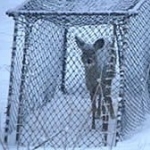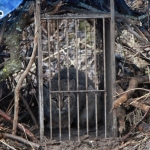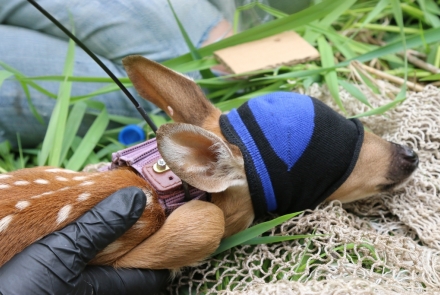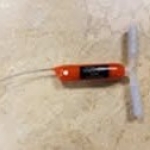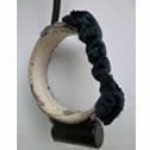How We Do Field Work
The Southwest Wisconsin CWD, Deer and Predator study has wrapped up the field work portion of the project and has moved on the its second phase, the data analysis phase. However, some have asked over the years how we captured and collared the study’s animals, so information on the trapping methods and collars used in this study are below.
HOW WE CAPTURE AND MONITOR DEER
To catch deer for this project, researchers used the following methods:
Netted Cage Traps
Netted cage traps were a metal-framed trap, wrapped in netting with a single door that the deer walked through to get to the bait in the back of the trap. When the deer got to the bait, it bumped the trigger wire, strung about 6" off the ground inside the trap, and the netted door closed behind the deer.
Box Traps
Box traps were wooden traps with two doors (bait side is blocked by hog wire) that the deer could only enter from one side. When the deer walked to the bait in the back of the trap, it bumped the trigger wire, strung about 6” off the ground inside the trap, and the two doors dropped to trap the deer.
Drop Nets
The drop nets we used were large nets suspended several feet off the ground that have a central trigger point that held up the net. When deer came to the bait in the center of the net, the net operator triggered the net switch, and the net dropped on top of the deer.
Darting
Darting involved using a dart projector that shot a transmitter dart at a relatively low velocity to administer anesthesia to the deer. The dart staid attached to the deer to transmit the deer's location to the capture team using a VHF frequency. Using this technique, deer were usually captured within 15 yards or less of the person who fired the dart.
HOW WE CAPTURE AND MONITOR BOBCATS AND COYOTES
Collaboration with the Public
One approach for capturing bobcats and coyotes was to rely on trappers and landowners to voluntarily report captured bobcats and coyotes. Reported bobcats and coyotes were collared and released by the researchers.
Cage Traps
Researchers also used live traps as necessary, such as cage traps, to capture bobcats and coyotes. Scent lures and visual attractants were placed at the back of the cage. When the animal entered, it stepped on a treadle that closed the door behind it.
MONITORING LOCATION AND SURVIVAL
Once an animal was captured, it was fit with a tracking devices to monitor the animal. We used five different monitoring devices in this study.
VITS
We used vaginal implant transmitters (VIT) to help us locate fawns born to does we have collared. The transmitter was implanted in the doe during the winter months. In the spring (May and June) when the doe gives birth, the transmitter sends a signal telling us that the doe possibly gave birth. Researchers then located the transmitter and the fawn(s) nearby for collaring. This type of monitoring allows us to track both the doe and fawn to examine potential effects of predation and disease on doe-fawn pairs.
Collaring Does
Does we captured were collared by researchers using standard GPS collars that don't expand. Researchers allowed for growth of the doe by adding another inch or two of space when placing the collars on the does. The GPS collars send locations twice a day depending on environmental conditions (weather, tree canopy density and topography). Collars can even let researchers know if the collared deer has possibly died by sending a text message when the collar doesn't move for more than 4-6 hours.
Collaring Fawns
Fawns we captured were collared using expandable drop-away VHF collars that have pleats sewn into the collar that pop and expand as the fawn grows. The elastic in the collar is designed to have the collar fall off within approximately 18 months of capture. Researchers use telemetry equipment to check the fawn’s location once per day to determine if the collared fawn has potentially died. The signal changes its pulse rate when the collar hasn't moved for more than 6-8 hours.
Collaring Bucks
Adult bucks were collared using expandable GPS collars that stretch during the rut and also have pleats that pop to allow the collar to expand as the bucks grows. The GPS collars send locations at least twice a day, depending on environmental conditions (weather, tree canopy density and if the deer is in a valley or on a hill). These collars also let researchers know if the buck hasn’t moved in 4-6 hours, potentially indicating a mortality.
Collaring and Monitoring Bobcats and Coyotes
Bobcats and coyotes were collared with GPS collars that record and transmit the location of the animal multiple times per day. The collars weigh five percent of the animal's weight or less, and researchers gave an extra inch or two of space when fitting the collar on the animal to allow for growth. The collars send six to eight locations a day and alerts researchers when the collar is stationary for more than six hours.


